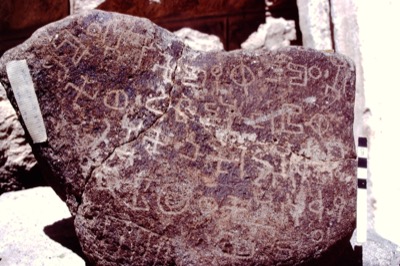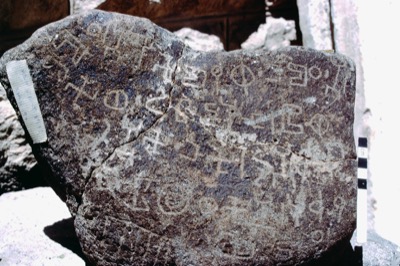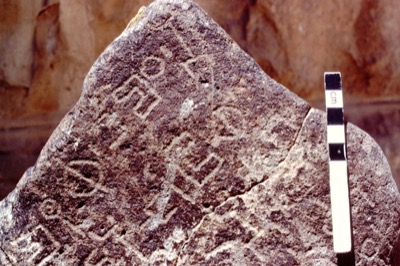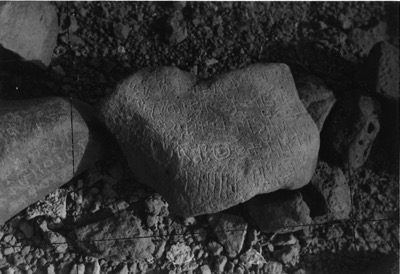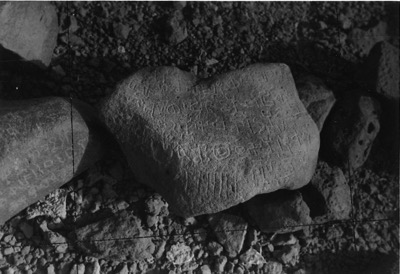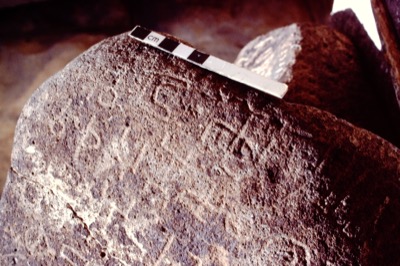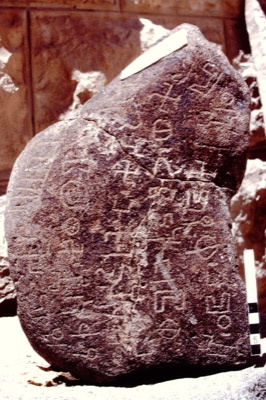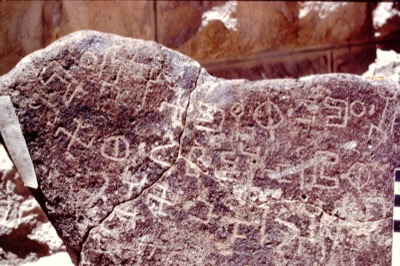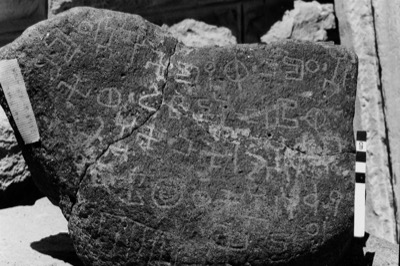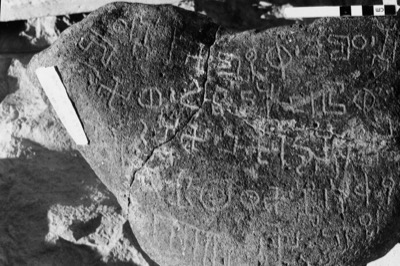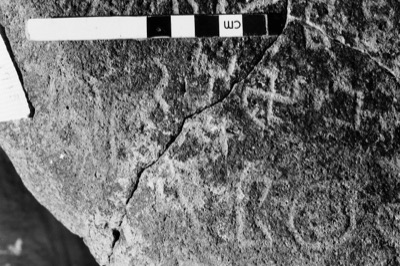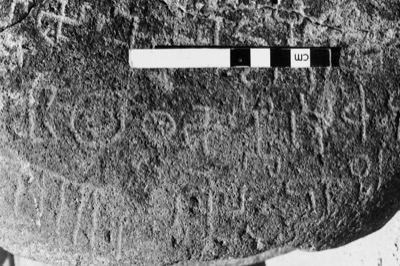Siglum: HCH 194 Script: Safaitic
Transliteration
l ʾnʿm bn qṣmt ḏ- ʾl ʿmrt w nfr f ʾs¹lm w b{ʿ}{d} ʾflt s¹nt ʾs²rq rḍwt ʾl- hdy l- ym{n}t
Translation
By ʾnʿm son of Qṣmt of the lineage of ʿmrt and he deserted and then surrendered but later escaped the year Rḍwt the leader migrated southwards to the inner desert
Apparatus Criticus
HCH: qymt for qṣmt; w nfr f ʾs¹lm w bn -h ʾflt s¹nt ʾḫrq (ʾġrq) rgwt ʾl hdy l- ymt "and he fled and deserted and his son escaped when he dispersed (ʾafraq = farraqa) (or submerged) the hope of the Jews that he would die".
MTB p. 43: w nẓr f ʾs¹lm w bn h- ʾẓlt s¹nt ʾs²rq rgʿt ʾl hdy ḥmt "he was entrusted with keeping watch and (now all) goes well for he has just built a good shelter (from the sun and the wind) the year of the migration to the east under the leadership for a second time of Ḥmt the guide".
JSFP p.415: qṣmt.
JMAA XIII p. 123-124: w nẓr f ʾs¹lm w qwd ʾflt s¹nt ʾs²rq rḍqt ʾl hdyk mt "and he was on the look-out and he saved and led ʾflt the year rḍgt went eastward to hdyk [who] died".
TaIm p. 59: l ʾnʿm bn qymt ḏ- ʾl ʿmrt w nfr f ʾs¹lm w bn -h ʾflt s¹nt ʾḫrq rgwt ʾl- hdy l- ymt suggesting that ʾflt is an example of ibdāl of [t for [ṭ].
Commentary
Bʿd would be baʿdu "afterwards" and ʾflt the IV form of falata "he escaped" (Lane 2435 b). This is the first occurrence of this verb in Safaitic and shows that it was distinguished from the verb flṭ "to save deliver". The ḍ in rḍwt has the Hismaic form occasionally found in Safaitic, especially in this name in which it is almost always used. Note also that the name is particularly popular among the ʾl ʿmrt. The reading and interpretation of the end of the text are from Al-Jallad & Jaworska 2019. Note that this is one of the rare occasions on which the definite article ʾl- is used in Safaitic. The text is an excellent demonstration that, like šarraq among the Rwala Bedouin, ʾs²rq for the authors of these inscriptions meant "he migrated to the inner desert, regardless of the direction taken" (Macdonald 1992: 4, 6).
Subjects
Genealogy
Lineage
Military
Date (s1nt)
Transhumance
Country: Jordan
Region: Al-Mafraq Governorate
Site: Cairn c. 1 5 km S.W. of Cairn of Haniʾ
Latitude: 32.238590
Longitude: 37.249047
Present Location: Amman Museum J (1918)
Field collector: G.L. Harding
Notes: H5/Safawi
Associated Signs: 7 lines attached by a horizontal line
Associated Remains: Cairn
References:
[HCH] Harding, G.L. The Cairn of Haniʾ. Annual of the Department of Antiquities of Jordan 2, 1953: 8-56, pls 1-7.
[JSFP] Jamme, A. Safaitic f as a Preposition and a Particle Indicating a Temporal Succession. Orientalia 39, 1970: 412-418.
[JMAA XIII] Jamme, A. V.A. Clark's Paper on the Cairn Question. Pages 125-134 in A. Jamme, Miscellanées d'ancient arabe XIII. Washington, DC: [privately produced], 1983.
Lane, E.W. An Arabic-English Lexicon, Derived from the Best and Most Copious Eastern Sources. (Volume 1 in 8 parts [all published]). London: Williams & Norgate, 1863-1893.
[MTB] Milik, J.T. La tribu des Bani ʿAmrat en Jordanie de l'époque grecque et romaine. Annual of the Department of Antiquities of Jordan 24, 1980: 41-54.
[Talm] Ṭalāfḥah [Talafha], Z.A. The ʾimālah and the Phonetic Interchange ʾibdāl in the Safaitic Inscriptions. Pages 51-62 [Arabic section] 102 [English Summary] in O. Ghul & A. Zeyadeh (eds), Proceedings of Yarmouk Second Annual Colloquium on Epigraphy and Ancient Writings 7th — 9th October, 2003. Irbid: Department of Epigraphy, Faculty of Archaeology & Anthropology, Yarmouk University, 2005.
URL of this record (for citation): http://krc.orient.ox.ac.uk/ociana/corpus/pages/OCIANA_0003047.html
